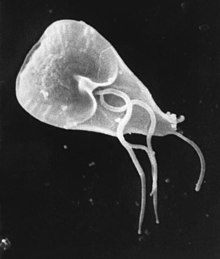Giardia lamblia
| Giardia lamblia | |
|---|---|
 |
|
| Giardia lamblia cell, SEM | |
| Scientific classification | |
| Domain: | Eukaryota |
| (unranked): | Excavata |
| Phylum: | Metamonada |
| Order: | Diplomonadida |
| Family: | Hexamitidae |
| Genus: | Giardia |
| Species: | G. lamblia |
| Binomial name | |
|
Giardia lamblia (Lambl, 1859) Kofoid & Christiansen, 1915 |
|
| Synonyms | |
|
|
Giardia lamblia, also known as Giardia intestinalis, is a flagellated parasite that colonizes and reproduces in the small intestine, causing giardiasis. The parasite attaches to the epithelium by a ventral adhesive disc, and reproduces via binary fission. Giardiasis does not spread via the bloodstream, nor does it spread to other parts of the gastrointestinal tract, but remains confined to the lumen of the small intestine.Giardia trophozoites absorb their nutrients from the lumen of the small intestine, and are anaerobes. If the organism is split and stained, its characteristic pattern resembles the familiar "smiley face" symbol. Chief pathways of human infection include ingestion of untreated sewage, a phenomenon particularly common in many developing countries; contamination of natural waters also occurs in watersheds where intensive grazing occurs.
Giardia infects humans, but is also one of the most common parasites infecting cats, dogs and birds. Mammalian hosts also include dozen of species, including cattle, sheep, and goats.
Giardia infection can occur through ingestion of dormant microbial cysts in contaminated water, food, or by the fecal-oral route (through poor hygiene practices). The cyst can survive for weeks to months in cold water, so can be present in contaminated wells and water systems, especially stagnant water sources, such as naturally occurring ponds, storm water storage systems, and even clean-looking mountain streams. They may also occur in city reservoirs and persist after water treatment, as the cysts are resistant to conventional water treatment methods, such as chlorination and ozonolysis.Zoonotic transmission is also possible, so Giardia infection is a concern for people camping in the wilderness or swimming in contaminated streams or lakes, especially the artificial lakes formed by beaver dams (hence the popular name for giardiasis, "beaver fever").
...
Wikipedia
